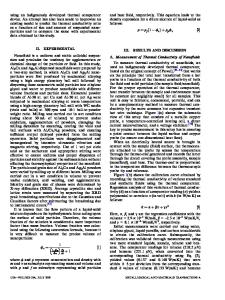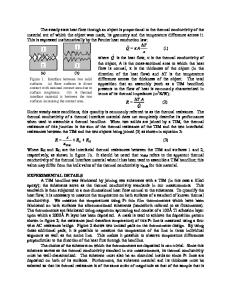Effect of Mechanical Damage on the Thermal Conductivity of Granite
- PDF / 3,189,417 Bytes
- 13 Pages / 595.276 x 790.866 pts Page_size
- 44 Downloads / 365 Views
ORIGINAL PAPER
Effect of Mechanical Damage on the Thermal Conductivity of Granite Zheng‑Wei Li1 · Xia‑Ting Feng1 · Yan‑Jun Zhang2 · Yan‑Hua Gong1 · Guo‑Qiang Zhu3 Received: 26 September 2018 / Accepted: 21 August 2019 © Springer-Verlag GmbH Austria, part of Springer Nature 2019
Abstract In this work, the effect of mechanical damage on the thermal conductivity of granite was experimentally investigated. Granite samples were artificially damaged through cyclic loading and unloading tests, with the strain evolution and acoustic emission activity monitored simultaneously. P-Wave velocity of the damaged samples was tested to evaluate the damage effect. Thermal conductivity of the undamaged and damaged granite samples was tested using optical scanning method. The influence of mechanical damage on thermal conductivity was analyzed. Thermal conductivity difference in different testing directions was analyzed based on the experiment results in six scanning lines on the two surfaces of each disk sample. The results indicate that thermal conductivity of damaged samples reduced compared with that of the undamaged samples, while the thermal inhomogeneity factor increased. Thermal conductivity increased in water-saturated condition for both undamaged and damaged samples. The increased rate of damaged samples was bigger than that of the undamaged samples. The mechanical damage treatment caused the increase in the thermal conductivity difference in different testing directions. The difference decreased when samples were water saturated. Research results in this work can provide better knowledge to the evolution mechanism of thermal conductivity of engineering rock masses. Keywords Thermal conductivity · Mechanical damage · Optical scanning · Thermal inhomogeneity · Water saturation
1 Introduction Heat transfer in engineering rock masses is a very important scientific issue in rock mechanics and rock engineering, such as the underground disposal of high-level radioactive waste (Tsang et al. 2005), the development of geothermal energy from deep underground (Li et al. 2017, 2018), and tunneling in high temperature rock masses, etc. The initiation, propagation, and coalescence of microcracks will change the thermal conduction characteristics of the rock masses and further influence the evolution of temperature fields, which will ultimately influence the coupling process * Zheng‑Wei Li [email protected]; [email protected] 1
Key Laboratory of Ministry of Education on Safe Mining of Deep Metal Mines, Northeastern University, Shenyang 110819, People’s Republic of China
2
College of Construction Engineering, Jilin University, Changchun 130026, People’s Republic of China
3
State Key Laboratory of Geomechanics and Geotechnical Engineering, Institute of Rock and Soil Mechanics, Chinese Academy of Sciences, Wuhan 430071, People’s Republic of China
of stress, hydrological, and chemical fields. For example, in the underground disposal of high-level radioactive waste, the damage accumulation in surrounding rock
Data Loading...










